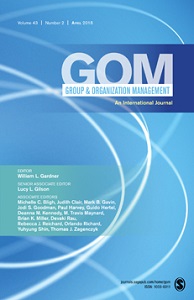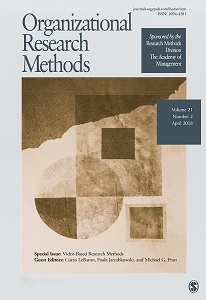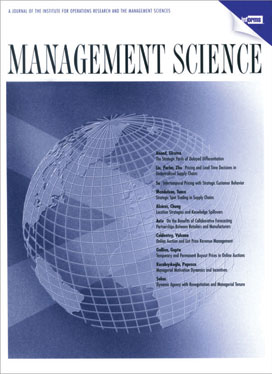Academic articles
Practitioner articles
Working papers
Books
Book chapters
Case studies
Other publications
Subject(s)
Marketing
Keyword(s)
Service expectations, customer satisfaction, information processing, ability to evaluate, motivation to evaluate
JEL Code(s)
M310
Extant research established that customers’ expectations play an ambivalent role in the satisfaction formation process: while higher expectations are more difficult to meet and thus cause dissatisfaction, they simultaneously increase satisfaction via customers’ perceived performance owing to a placebo effect. However, to date, knowledge is scarce on the question under which conditions either the positive or negative effect of expectations on satisfaction prevails. Building on information processing theory, the authors hypothesize that an essential contingency of the indirect, placebo-based effect is the degree to which customers are able and motivated to process a service experience. Three studies with a total of over 4,000 customers in different service contexts provide strong evidence for this hypothesis. Thus, managers are well advised to provide a realistic or even understated prospect if the service context favors customers’ ability or motivation to evaluate. Conversely, if customers are neither able nor motivated to evaluate the service, increasing customer expectations represents a viable strategy to enhance satisfaction. Relatedly, if customers hold low service expectations, managers should foster customers’ ability and motivation to evaluate the service. In contrast, if service expectations are high, managers may benefit from reducing the likelihood that customers overly focus on the service performance.
With permission of SAGE Publishing
Volume
19
Journal Pages
361–379
Subject(s)
Economics, politics and business environment
Keyword(s)
Multimarket firms, entry, predation, reputation
Volume
81
Journal Pages
571–579
Subject(s)
Human resources management/organizational behavior
Keyword(s)
Decision making, ethics, psychology, research management
We present the data from a crowdsourced project seeking to replicate findings in independent laboratories before (rather than after) they are published. In this Pre-Publication Independent Replication (PPIR) initiative, 25 research groups attempted to replicate 10 moral judgment effects from a single laboratory’s research pipeline of unpublished findings. The 10 effects were investigated using online/lab surveys containing psychological manipulations (vignettes) followed by questionnaires. Results revealed a mix of reliable, unreliable, and culturally moderated findings. Unlike any previous replication project, this dataset includes the data from not only the replications but also from the original studies, creating a unique corpus that researchers can use to better understand reproducibility and irreproducibility in science.
Volume
3
ISSN (Online)
2052-4463
Subject(s)
Management sciences, decision sciences and quantitative methods
Keyword(s)
Shapley value, potential, random partition, concentration of power, communication graph, fairness, efficiency, efficient extension, fair extension, Myerson value
JEL Code(s)
C71, D60
We study values for TU games with a communication graph (CO-values). In particular, we show that CO-values for connected graphs that are fair and efficient allow for a unique efficient and fair extension to the full domain.
With permission of Elsevier
Volume
146
Journal Pages
103–106
Subject(s)
Human resources management/organizational behavior
Keyword(s)
Crowdsourcing science, replication, reproducibility, research transparency, methodology, meta-science
This crowdsourced project introduces a collaborative approach to improving the reproducibility of scientific research, in which findings are replicated in qualified independent laboratories before (rather than after) they are published. Our goal is to establish a non-adversarial replication process with highly informative final results. To illustrate the Pre-Publication Independent Replication (PPIR) approach, 25 research groups conducted replications of all ten moral judgment effects which the last author and his collaborators had “in the pipeline” as of August 2014. Six findings replicated according to all replication criteria, one finding replicated but with a significantly smaller effect size than the original, one finding replicated consistently in the original culture but not outside of it, and two findings failed to find support. In total, 40% of the original findings failed at least one major replication criterion. Potential ways to implement and incentivize pre-publication independent replication on a large scale are discussed.
With permission of Elsevier
Volume
66
Journal Pages
55–67
Subject(s)
Human resources management/organizational behavior
Keyword(s)
Team adaptiveness, patterned team interactions, in-process planning, dynamic situations, simulation
Previous research asserts that teams working in routine situations pass through performance episodes characterized by action and transition phases, while other evidence suggests that certain team behaviors significantly influence team effectiveness during nonroutine situations. We integrate these two areas of research—one focusing on the temporal nature of team episodic performance and the other on interaction patterns and planning in teams—to more fully understand how teams working in dynamic settings successfully transition across routine and nonroutine situations. Using behavioral data collected from airline flight crews working in a flight simulator, we find that different interaction pattern characteristics are related to team performance in routine and nonroutine situations, and that teams engage in more contingency, in-process planning behavior during routine versus nonroutine situations. Moreover, we find that the relationship between this in-process planning and subsequent team adaptiveness is curvilinear (inverted U-shaped). That is, team contingency or in-process planning activity may initially increase team adaptiveness, but too much planning has adverse effects on subsequent performance.
With permission of SAGE Publishing
Volume
41
Journal Pages
491–525
ISSN (Online)
1552-3993
Subject(s)
Human resources management/organizational behavior
Keyword(s)
Multivariate analysis, computational modeling, team diversity, categorization salience, leadership
It is increasingly recognized that team diversity with respect to various social categories (e.g., gender, race) does not automatically result in the cognitive activation of these categories (i.e., categorization salience), and that factors influencing this relationship are important for the effects of diversity. Thus, it is a methodological problem that no measurement technique is available to measure categorization salience in a way that efficiently applies to multiple dimensions of diversity in multiple combinations. Based on insights from artificial intelligence research, we propose a technique to capture the salience of different social categorizations in teams that does not prime the salience of these categories. We illustrate the importance of such measurement by showing how it may be used to distinguish among diversity-blind responses (low categorization salience), multicultural responses (positive responses to categorization salience), and intergroup biased responses (negative responses to categorization salience) in a study of gender and race diversity and the gender by race faultline in 38 manufacturing teams comprising 239 members.
With permission of SAGE Publishing
Volume
19
Journal Pages
433–474
Subject(s)
Management sciences, decision sciences and quantitative methods; Product and operations management
Keyword(s)
Cooperation, competition, supply risk, coalition stability, supplier alliances
We study the alliance formation strategy among suppliers in a framework with one downstream firm and n upstream suppliers. Each supplier faces an exogenous random shock that may result in an order default. Each of them also has access to a recourse fund that can mitigate this risk. The suppliers can share the fund resources within an alliance, but they need to equitably allocate the profits of the alliance among the partners. In this context, suppliers need to decide whether to join larger alliances that have better chances of order fulfillment or smaller ones that may grant them higher profit allocations. We first analytically characterize the exact coalition-proof Nash-stable coalition structures that would arise for symmetric complementary or substitutable suppliers. Our analysis reveals that it is the appeal of default risk mitigation, rather than competition reduction, that motivates cooperation. In general, a riskier and/or less fragmented supply base favors larger alliances, whereas substitutable suppliers and customer demands with lower pass-through rates result in smaller ones. We then characterize the stable coalition structures for an asymmetric supplier base. We establish that grand coalition is more stable when the supplier base is more homogeneous in terms of their risk levels, rather than divided among a few highly risky suppliers and other low-risk ones. Going one step further, our investigation of endogenous recourse fund levels for the suppliers demonstrates how financing costs affect suppliers’ investments in risk-reducing resources and, consequently, their coalition formation strategy. Last, we discuss model generalizations and show that, in general, our insights are quite robust.
© 2016 INFORMS
Volume
62
Journal Pages
1297–1315
ISSN (Online)
1526-5501
ISSN (Print)
0025–1909
Subject(s)
Human resources management/organizational behavior; Management sciences, decision sciences and quantitative methods; Strategy and general management
Keyword(s)
Status, performance feedback theory, decision making, college
rankings, Chivas Regal effect, pricing, signaling
This paper examines the effect of status loss on organizations’ price-setting behavior. We predict, counter to current status theory and aligned with performance feedback theory, that a status decline prompts certain organizations to charge higher prices and that there are two kinds of organizations most prone to make such price increases: those with broad appeal across disconnected types of customers and those whose most strategically similar rivals have charged high prices previously. Using panel data from U.S. News & World Report’s annual rankings of private colleges and universities from 2005 to 2012, we model the effect of drops in rank that take a school below an aspiration level. We find that schools set tuition higher after a sharp decline in rank, particularly those that appeal widely to college applicants and whose rivals are relatively more expensive. This study presents a dynamic conception of status that differs from the prevailing view of status as a stable asset that yields concrete benefits. In contrast to past work that has assumed that organizations passively experience negative effects when their status falls, our results show that organizations actively respond to status loss. Status is a performance related goal for such producers, who may increase prices as they work to recover lost ground after a status decline.
With permission of Sage
Volume
61
Journal Pages
217–253
Subject(s)
Management sciences, decision sciences and quantitative methods
Keyword(s)
Equal division, weighted division values, non-negative player, addition invariance on bi-partitions, nullified solidarity
Volume
80
Journal Pages
649–667




